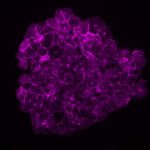Link to Pubmed [PMID] – 29322086
Link to DOI – 10.1016/j.jcmgh.2017.11.005
Cell Mol Gastroenterol Hepatol 2018 ; 5(2): 131-144
Engineered liver systems come in a variety of platform models, from 2-dimensional cocultures of primary human hepatocytes and stem cell-derived progeny, to 3-dimensional organoids and humanized mice. Because of the species-specificity of many human hepatropic pathogens, these engineered systems have been essential tools for biologic discovery and therapeutic agent development in the context of liver-dependent infectious diseases. Although improvement of existing models is always beneficial, and the addition of a robust immune component is a particular need, at present, considerable progress has been made using this combination of research platforms. We highlight advances in the study of hepatitis B and C viruses and malaria-causing Plasmodium falciparum and Plasmodium vivax parasites, and underscore the importance of pairing the most appropriate model system and readout modality with the particular experimental question at hand, without always requiring a platform that recapitulates human physiology in its entirety.


